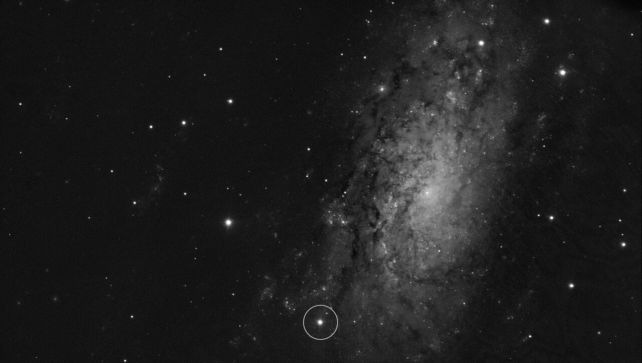For the first time, scientists determined the shape of a supernova's shock front as it burst through the surface of a dying star.
Spotted erupting exceptionally early in April 2024 from 23.6 million light-years away, supernova SN 2024ggi briefly displayed an ovoid, olive-like shape before its shock front collided with surrounding material – an observation that fills in some of the blanks about the very earliest stages of supernova evolution.
These details would not have been evident if the event had been caught just a day later, highlighting the scientific value of early supernova detection, the agility to mobilize equipment to home in on the source, and why different observation techniques matter.
Related: The Most Powerful Space Explosion Ever Seen Reveals a Surprise Twist
"The geometry of a supernova explosion provides fundamental information on stellar evolution and the physical processes leading to these cosmic fireworks," says astrophysicist Yi Yang of Tsinghua University in China, first author on the new paper describing SN 2024ggi.

The death of a massive star is a complicated process instigated by the depletion of fusible fuel in that star's core. Stars maintain a delicate balance. They meld lighter atoms in their core to create heavier elements – hydrogen into helium, and so forth. Because the products of this fusion have a lower mass than their constituent elements, the extra mass turns into the energy that supplies the outward pressure keeping the star stable.
For stars above a certain mass, eons of fusing lighter elements into heavier ones eventually fill their cores with iron – the end point of fusion. Because forging elements heavier than iron would consume more energy than it releases, the core can no longer generate the outward pressure that keeps the star stable. That's the trigger point for a supernova.
What happens next happens very quickly. The star begins to implode, generating a shockwave that propagates inward toward its core, where it rebounds and erupts outward, punching through the star's outer surface.
There's a very brief time before this outward-propagating shock collides with the slower-moving gas the star had sneezed off in the centuries before it died.

This brief window is the shock-breakout phase – the moment the shock punches through the star's surface, followed quickly by a flash of light that fades in hours.
Astronomers have captured it a few times over the years, in varying levels of detail. What makes the new observations of SN 2024ggi stand out is the spectropolarimetry using the European Southern Observatory's Very Large Telescope – a technique that measures the polarization of light across a range of wavelengths.
"Spectropolarimetry delivers information about the geometry of the explosion that other types of observation cannot provide because the angular scales are too tiny," explains astronomer Lifan Wang of Texas A&M University.
The researchers began spectropolarimetric observations of the evolution of SN 2024ggi just 26 hours after it was detected, and continued observing it over multiple days. Remarkably, their observations captured the breakout phase, revealing a shockwave that was not spherical but stretched into an olive- or football-like shape along a preferred axis.
"The first VLT observations captured the phase during which matter accelerated by the explosion near the centre of the star shot through the star's surface," says astronomer Dietrich Baade of the European Southern Observatory. "For a few hours, the geometry of the star and its explosion could be, and were, observed together."
As the supernova continued to evolve, the astronomers saw that shape again in the expanding hydrogen-rich material blasted outward. This suggests that the shape of the breakout phase is not random but is driven by a large-scale mechanism that preserves the well-defined preferred axis from the early stages through later evolution.
However, as the shock propagated into the material previously shed by the star in the centuries before the supernova, the preferred axis shifted – suggesting that the surrounding material had a different orientation from the explosion's own axis.
What this means is unclear, but one possibility is that the star may have (or had) a binary companion whose gravitational influence shaped its death.
That's a pretty amazing thing to be able to figure out from 23.6 million light-years away.
The research has been published in Science Advances.

